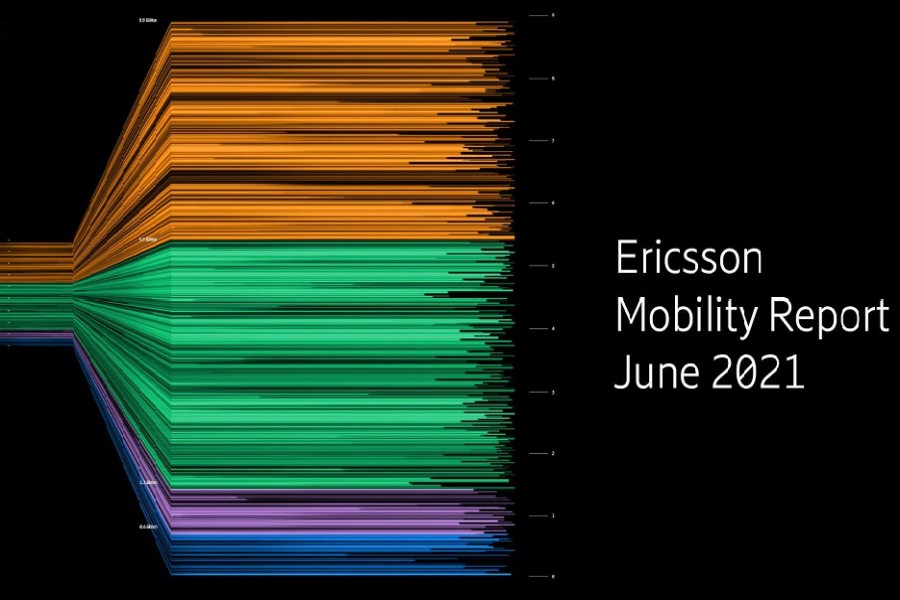
Published :
Updated :

5G mobile subscriptions will exceed 580 million by the end of 2021 owing to an estimated one million new 5G mobile subscriptions every day, said a report by Ericsson.
The forecast, which features in the twentieth edition of the Ericsson Mobility Report, enhances the expectation that 5G will become the fastest adopted mobile generation.
As per the report, about 3.5 billion 5G subscriptions and 60 per cent 5G population coverage are forecast by the end of 2026.
However, the pace of adoption varies widely by region. Europe is off to a slower start and has continued to fall far behind China, the US, South Korea, Japan and the Gulf Cooperation Council (GCC) markets in the pace of 5G deployments.
5G is expected to surpass 1.0 billion subscriptions two years ahead of the 4G LTE timeline for the same milestone. Key factors behind that include China’s earlier commitment to 5G and the earlier availability and increasing affordability of commercial 5G devices. More than 300 5G smartphone models have already been announced or launched commercially.
This commercial 5G momentum is expected to continue in coming years, spurred by the enhanced role of connectivity as a key component of post-COVID-19 economic recovery.
North East Asia is expected to account for the largest share of 5G subscriptions by 2026, with an estimated 1.4 billion 5G subscriptions. While North American and GCC markets are expected to account for the highest 5G subscription penetration, with 5G mobile subscriptions comprising 84 per cent and 73 per cent of all regional mobile subscriptions respectively.
Mobile subscriptions in the South East Asia and Oceania region have now exceeded 1.1 billion, with 5G subscriptions being just below the 2.0 million mark.
5G subscriptions are expected to grow strongly over the next few years with a forecast total of about 400 million by 2026. South East Asia and Oceania region will also see data traffic per smartphone growing at the fastest rate globally, reaching 39GB/month by 2026 – a CAGR of 36 per cent. Total mobile data traffic will grow accordingly, with a CAGR of 42 per cent, reaching 39EB/month driven by continued growth in 4G subscriptions and 5G uptake in those markets where 5G has already been launched.
Fredrik Jejdling, Executive Vice President and Head of Networks, Ericsson, says: “This landmark twentieth edition of Ericsson Mobility Report shows that we are in the next phase of 5G, with accelerating rollouts and coverage expansion in pioneer markets such as China, the USA and South Korea. Now is the time for advanced use cases to start materialising and deliver on the promise of 5G. Businesses and societies are also preparing for a post-pandemic world, with 5G-powered digitalisation playing a critical role.”
Abdus Salam, Head of Ericsson Bangladesh, says, “In Bangladesh, mobile technology has been at the centre of the country’s rapid industry digital transformation. Going beyond the existing technologies that have played a key role in Bangladesh’s digital development, 5G can address the rapid data growth and reduce cost per GB, which can further stimulate the digital economy in Bangladesh through innovation driven platforms and accelerate realizing the ‘Digital Bangladesh’ vision. “
Smartphones and video driving mobile data traffic
Data traffic continues to grow year on year. One exabyte (EB) comprises 1,000,000,000 (1.0 billion) gigabytes (GB). Global mobile data traffic - excluding traffic generated by fixed wireless access (FWA) - exceeded 49 EB per month at the end of 2020 and is projected to grow by a factor of close to five to reach 237 EB per month in 2026. Smartphones, which currently carry 95 per cent of this traffic, are also consuming more data than ever. Globally, the average usage-per-smartphone now exceeds 10GB/month and is forecast to reach 35GB/month by the end of 2026.
5G Communications Service Providers at the forefront of Fixed Wireless Access adoption
The COVID-19 pandemic is accelerating digitalisation, and increasing the importance of, and need for reliable, high-speed mobile broadband connectivity. According to the latest report, almost nine out of ten communications service providers (CSPs) that have launched 5G also have a fixed wireless access (FWA) offering (4G and/or 5G), even in markets with a high fibre penetration. This is needed to accommodate increasing FWA traffic, which the report forecasts to grow by a factor of seven to reach 64EB in 2026.
Massive IoT on the rise
Massive IoT technologies NB-IoT and Cat-M connections are forecast to increase by almost 80 per cent during 2021, reaching almost 330 million connections. In 2026, these technologies are forecast to make up 46 per cent of all cellular IoT connections.
A closer look: The Gulf Cooperation Council
The report features breakout statistics from GCC markets where government-sponsored digital initiatives are accelerating both technological innovation and expected 5G uptake. In 2019, GCC markets were among the first in the world to launch commercial 5G services. By 2026, they are forecast to manage a combined 62 million 5G subscriptions, accounting for the second highest 5G market penetration globally.


 For all latest news, follow The Financial Express Google News channel.
For all latest news, follow The Financial Express Google News channel.